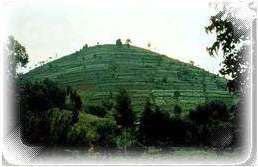

|
|
Living in a Poor Country For the people living near the
mountain gorilla habitat of the Virunga mountains, obtaining the basics, such as food,
shelter, and clothing, is a major challenge. Nearly all these people are either farmers,
ranchers, or hunters and gatherers. Each of these methods of subsistence requires large
tracts of land, which are becoming more and more scarce as the surrounding population
continues to grow. Above left:
Almost all of Rwanda is cultivated, even the steepest slopes. Photo: Courtesy of the Dian Fossey Gorilla Fund For the people living near the
mountain gorilla habitat of the Virunga mountains, obtaining the basics, such as food,
shelter, and clothing, is a major challenge. Nearly all these people are either farmers,
ranchers, or hunters and gatherers. Each of these methods of subsistence requires large
tracts of land, which are becoming more and more scarce as the surrounding population
continues to grow. Above left:
Almost all of Rwanda is cultivated, even the steepest slopes. Photo: Courtesy of the Dian Fossey Gorilla Fund
What is it like to live in poverty? How much time might you spend doing simple tasks, such as getting water and gathering fuel with which to cook? The average annual income of Rwanda is $200. In order for you to live on $200 a year, you would have to do the following:
[ Economics of Rwanda ] [ Economics of Uganda ] [ Home ] [ Teacher Pages ] [ Modules & Activities ] |
HTML code by Chris Kreger
Maintained by ETE Team
Last updated April 28, 2005
Some images © 2004 www.clipart.com
Privacy Statement and Copyright © 1997-2004 by Wheeling Jesuit University/NASA-supported Classroom of the Future. All rights reserved.
Center for Educational Technologies, Circuit Board/Apple graphic logo, and COTF Classroom of the Future logo are registered trademarks of Wheeling Jesuit University.